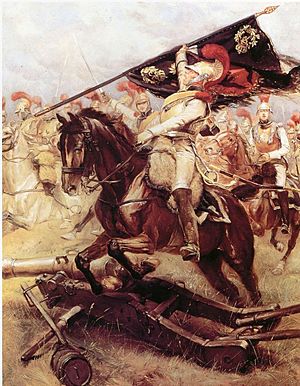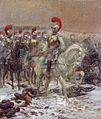French invasion of Russia facts for kids
The French Invasion of Russia happened in 1812. It's also called the Russian Campaign in France and the Patriotic War of 1812 in Russia. This was when Napoleon Bonaparte, the leader of the French Empire, decided to invade Russia.
This invasion was a huge turning point during the Napoleonic Wars. It was Napoleon's first major defeat. His huge army, called the Grande Armée, was almost completely destroyed. This event greatly weakened France's power across Europe. After this, France's allies, like Prussia and the Austrian Empire, broke their agreements. They then joined forces against France, starting the War of the Sixth Coalition.
Contents
What Was the French Invasion of Russia?
The French Invasion of Russia was a military campaign led by Emperor Napoleon Bonaparte. He wanted to force Russia to follow his rules. Russia had stopped supporting Napoleon's plan to block trade with Great Britain. This made Napoleon angry. He gathered a massive army from many parts of Europe to invade Russia.
Why Did Napoleon Invade Russia?
Napoleon had a plan called the Continental System. This plan was meant to stop all trade between Europe and Great Britain. He hoped this would weaken Britain. Russia was supposed to be part of this system. However, Russia started trading with Britain again. This made Napoleon very upset. He saw it as a challenge to his power. He decided to invade Russia to make them obey his rules.
The Grande Armée: A Giant Army
Napoleon's army for this invasion was enormous. It was called the Grande Armée, which means "Great Army" in French. It had over 600,000 soldiers. These soldiers came from France and many other countries that Napoleon controlled or were allied with him. It was one of the largest armies ever assembled at that time.
Crossing the Border
On June 24, 1812, the Grande Armée began crossing the Neman River. This river was the border between Napoleon's lands and Russia. The invasion started quickly, but the Russian army did not fight a big battle right away. Instead, they slowly retreated deeper into Russia.
The Russian Strategy: Retreat and Burn
The Russian army, led by generals like Kutuzov, used a smart strategy. They avoided major battles and kept retreating. As they moved back, they burned crops and villages. This was called a "scorched-earth" policy. It meant that Napoleon's army could not find food or supplies from the land. This made it very hard for the French soldiers to get what they needed.
Major Battles and Challenges
Even though the Russians mostly retreated, there were some big fights.
Battle of Smolensk
One important battle happened at Smolensk. The French captured the city, but it was mostly burned down. This meant Napoleon's army still couldn't find many supplies. The fighting was fierce, and both sides lost many soldiers.
Battle of Borodino
The biggest and bloodiest battle of the invasion was the Battle of Borodino. This happened close to Moscow. It was a very long and brutal fight. Both armies suffered huge losses. The French won the battle, but it was not a clear victory. The Russian army was badly hurt but not destroyed. They were able to retreat and save most of their forces.
Napoleon Enters Moscow
After the Battle of Borodino, Napoleon marched into Moscow. He expected the Russians to surrender. But when he arrived in September 1812, the city was almost empty. Most people had left. Soon after, a huge fire broke out in Moscow. Much of the city was destroyed. It's still debated who started the fire, but it left Napoleon's army without shelter or supplies.
The Long Wait and Retreat
Napoleon stayed in Moscow for over a month. He hoped the Russian Emperor would ask for peace. But no peace offer came. Winter was coming, and his army was running out of food and supplies. Napoleon realized he had to leave Moscow.
On October 19, 1812, Napoleon's army began its long retreat from Moscow.
The Disastrous Retreat
The journey back was a disaster for the Grande Armée.
Harsh Winter Conditions
The Russian winter arrived early and was extremely cold. Soldiers faced freezing temperatures, heavy snow, and strong winds. They were already weak from lack of food and supplies. Many soldiers froze to death or died from hunger and sickness.
Constant Attacks
As the French retreated, Russian soldiers, especially the Cossacks, constantly attacked them. These attacks, combined with the harsh weather, made the retreat even worse. The French army was slowly falling apart.
Crossing the Berezina River
One of the most difficult parts of the retreat was crossing the Berezina River. The French had to build temporary bridges under attack from the Russians. Thousands of soldiers died trying to cross the icy river. It was a terrible scene of chaos and loss.
The End of the Invasion
By the time the remains of the Grande Armée left Russia in December 1812, only a small fraction of the original 600,000 soldiers were left. Most had died from battle, hunger, disease, or the cold. Napoleon left his army and rushed back to France to raise a new one.
Impact and Aftermath
The French Invasion of Russia was a huge failure for Napoleon. It showed that he could be defeated. This defeat greatly weakened his power and encouraged other European countries to fight against him. It led to more wars that eventually ended Napoleon's rule. For Russia, it was a great victory and a moment of national pride.
Images for kids
-
Treaties of Tilsit signed on the Neman River
-
The Grande Armée crossing the Niemen by Waterloo Clark
-
Italian corps of Eugene de Beauharnais crossing the Niemen on 30 June 1812. Oil and gouache on paper by Albrecht Adam who travelled with IV Corps. In: Hermitage Museum
-
Cossacks feigning retreat against Polish uhlans at the Battle of Mir
-
General Raevsky leading a detachment of the Russian Imperial Guard at the Battle of Saltanovka
-
Kutuzov on the far left, with his generals at the talks deciding to surrender Moscow to the French
-
Bad News from France, painting depicting Napoleon encamped in a Russian Orthodox church (Vasily Vereshchagin, part of his series, "Napoleon, 1812", 1887–95)
-
The night bivouac of Napoleon's army during the retreat from Russia by Vasily Vereshchagin. Oil on canvas. Historical Museum, Moscow, Russia.
-
Kalmyks and Bashkirs attacking French troops at the Berezina
-
The hall of military fame in the Winter Palace with portraits of Russian generals
-
As irregular cavalry, the Cossack horsemen of the Russian steppes were best suited to reconnaissance, scouting and harassing the enemy's flanks and supply lines.
See also
 In Spanish: Invasión napoleónica de Rusia para niños
In Spanish: Invasión napoleónica de Rusia para niños



























